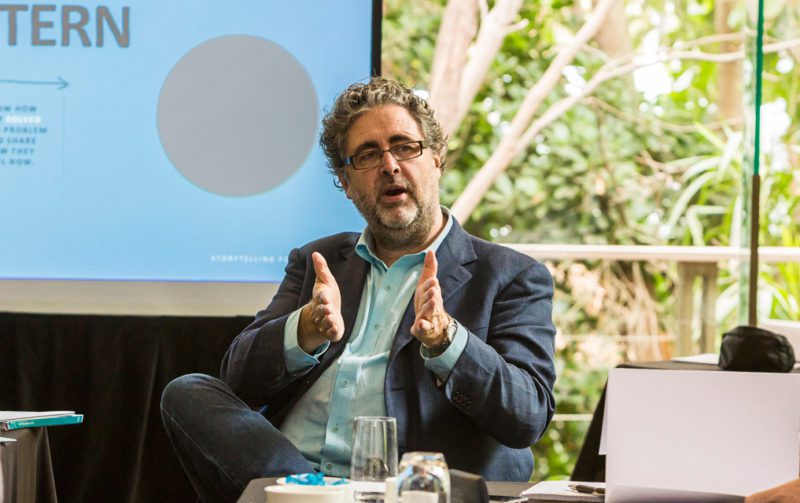020 – Shawn Callahan – Storytelling for Leaders
Author - Putting Stories to Work

Storytelling in the business setting is a dying art – and that’s a terrible shame.
Stories are so incredibly powerful for connecting, sharing information, motivating actions, clarifying direction, enjoying success…
But we have become slaves to PowerPoint, charts, dot-points and theoretical lenses.
My guest in this episode wants to change all that. Shawn Callahan is a storytelling consultant. He talks us through the benefits of telling great business stories and he steps us through a process that will help us all be better storytellers.
And, you guessed it; Shawn is a great storyteller himself. He brings to life all of his insight and advice with the use of powerful, memorable stories.
Hang on to your hats – once you listen to this episode you will never see business communication the same way again.
Lessons Learned
Here’s what I took from the episode:
Shawn Callahan – The Storytelling Consultant
As a story-telling consultant Shawn does not feel pressure to be a great storyteller – but he does feel pressure to actually tell stories. He has listened to so many talks in which presenters share wonderful information and data – but fail to share enough stories…or any stories at all. Subsequently, they lose their audience.
In trying to explain tacit capability – the things you can do but cannot explain – stories become a key element. It was working in this space within the field of knowledge-management that got Shawn really interested in the benefits and art of storytelling.
In his early stage of his storytelling career, Shawn met a guy who had the ability to speak all day with nothing but a flipchart and marker and the audience hung off every word he said. In breaking down how he managed it, Shawn realised that every time he would make a point he would tell a little anecdote that supported it – this is what had such a powerful effect on the audience.
Shawn started his business Anecdote to help organisations and leaders to find and tell their stories because he had noticed the humanity sliding away from business.
‘How can I bring more humanity back into these organisations? Stories!’
Why Should I Tell Stories?
Humans are natural storytellers – it’s been part of our way since before language. But at some point it died away from the organisational setting. A lot of workplace cultures have become slaves to slide decks and graphs. Perhaps it’s the ugly underbelly of the drive for efficiency and effectiveness. The irony is that stories do a much better job (efficient and effective) of sharing information, motivating action etc…
We tell stories to:
- To give people an experience they haven’t had first hand
- To inspire people to take action
When presenting to an audience in a formal setting, people often get caught up in showing great data, through the best consultant lenses, but ignore obvious opportunities to tell great stories that will have the effect of bringing to life the points they are making.
Stories are 7 times more likely to be remembered than argument, facts, data, graphs…etc.
Good stories tap into experiences and emotion.
The hierarchy of stories:
– Stories that happened
– Stories you can see something happen
– Stories you can feel something happen
When you tell a really interesting story, the audience begins to anticipate what is going to happen next. Scientific testing has shown that the pattern in the brains of the audience begin to mimic the brain pattern of the storyteller. What a great way to engage your audience!
Stories have to have a business point – it’s great to find colourful, interesting stories that are all around you – but they are useless unless they make a relevant point.
Story telling is important for leaders in an organisation because it inspires action. By evoking emotion, leaders create a greater connection with their colleagues.
Mostly people aren’t inspired to action through rationale and data, they have to have a feeling. So telling emotion-evoking stories is so much better than sharing numbers and evidence.
We almost always base decisions on our own experiences – so if you can’t give people a firsthand experience the next best thing is to tell them a story that gives them that experience vicariously.
How do I Tell Great Stories?
When you develop a desire to tell more stories, the first step is to begin finding them – to spot them in the wild. And you soon learn that they are not beautifully crafted, Hollywood pieces of work, they are short and sharp with concrete details – but most of all they help you to see a picture. It taps into our very powerful visual memory (that’s why stories are 7 times more likely to be remembered than data).
‘How do you develop storytelling as a habit of communication when you’re in an organisational setting?’
The best stories are the ones you can tell off the cuff – insert them into a conversation or presentation when they are required. Natural and relevant.
You have to practice telling your stories – so that you fine-tune the delivery and so that they are locked in to your memory, ready for release at the right time. Shawn thinks that once you tell a story three times it’s usually locked in to your memory.
Creating a new habit:
- Find a cue (for Shawn his ‘trigger’ for telling a story is when he finds himself being really opinionated about something)
- Execute a behaviour – tell a story
- Savour a reward – the audiences response to your story
We should try and tell small ‘S’ stories – anecdotes. Rather than Big ‘S’ stories – which replicate Hollywood storylines, usually centred around a complicated hero plot structure.
Four Steps to Telling Great Stories
- Discovery – stories are all around you – you just have to learn to spot them. Learn to listen for a couple of things that reveal a story:
- a time marker (‘a couple of days ago’);
- a place marker (‘I was in the board room…’)
- people
- dialogue (dialogue can only be part of a ‘story’)
- something unanticipated has to happen
- for it to be a business story, it has to have a business point
- Remember – practice telling them and ask (your test ) people what they think they mean so you can ‘tag’ them for future use (ok, this is a story about trusting your testing process…) and name them – Shawn uses the ‘Friends’ method – the one where…
- Sharing – this is where you actually start telling your stories. Shawn recommends starting small – share an example, an anecdote, that makes a point (it has to have a business point!)
- Refresh – use audience reaction, and your own judgement, to work out when to refresh and even retire certain stories
In a business setting it’s powerful to tell a story first and then present facts/argument/reasoning/plan to support the story (or stories). Not the other way around.
Everyone likes to hear a story – but they don’t like the word ‘story’. So don’t stand in front of a group and say that you’re going to tell them a story. Just start telling the story…’something really important happened a couple of days ago that I want to share with you…’
Types of Stories
We tell stories for:
- Connecting – so people get an insight into your character
- Clarity – Why? Why are we doing something. Really helpful to explain strategy: we used to do this – then this happened – so now we should do this – to enjoy this future
- Influence – to tackle stories within the organisation that are causing you pain (often they come in the form of anti-stories). To help change people’s mind. You can’t beat a story with fact. You can only beat a story with abetter story.
- Demonstrate success
These are the four basic patterns of stories, but there are many more story types.
Share this:





